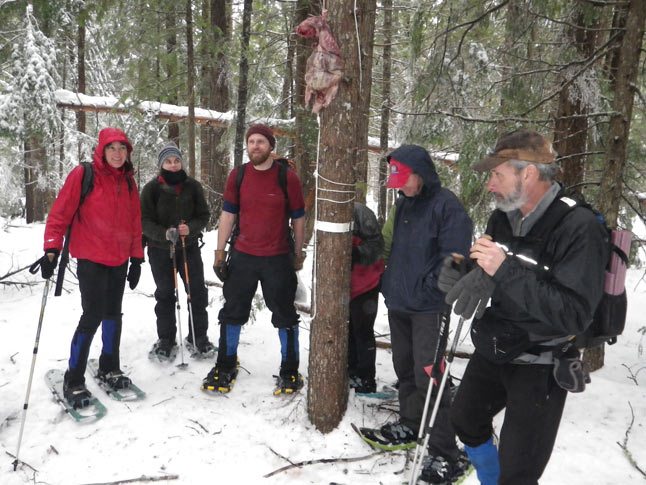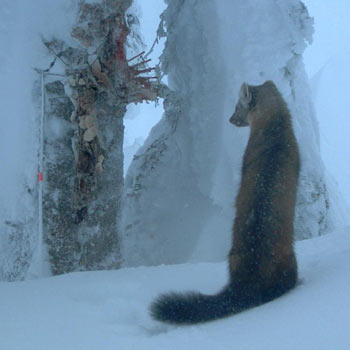 |

|
 Friends of Scotchman Peaks Wilderness volunteers listen up as IDFG personnel, Lacy Robinson and Michael Lucid, brief them on bait station maintenance. From left are Deb Hunsicker, Robinson, Lucid, Sandii Mellen (behind tree), Sandy Compton and Jim Mellen. Photo by Phil Hough Friends of Scotchman Peaks Wilderness volunteers listen up as IDFG personnel, Lacy Robinson and Michael Lucid, brief them on bait station maintenance. From left are Deb Hunsicker, Robinson, Lucid, Sandii Mellen (behind tree), Sandy Compton and Jim Mellen. Photo by Phil Hough
Wolverines, martens and fishers, oh my! Mustelid study confirms critters live in the Selkirks, Scotchmans
By Sandy Compton
The oceans off Russia's Kamchatka Peninsula are home to rare northern right whales. China's Heilongjiang Northeast Tiger Forest Park is sanctuary to Siberian tigers. The American Selkirks and West Cabinets, particularly the proposed Scotchman Peaks Wilderness on the Idaho-Montana border, harbor the family Mustelidae – not as rare as the right whale or Siberian tiger, but elusive, secretive and seldom seen even in places where they are relatively numerous. The family includes weasels (mustela in Latin), badgers, marten, fishers, otters, mink and ferrets.
Mustelids, primarily carnivorous, aren't shy about going after dinner, and at the top of the mustelid family is a legend of ferocity, endurance and cunning – Gulo gulo or "gluttonous glutton" – the wolverine. Rarely found below the 49th parallel these days, wolverines are called carcajou by Canadians, derived from the native kuàkuàtsheu, roughly translated as "devil dog." Topping out at 50 pounds and capable of taking down a moose or defending food from grizzlies, this critter is worthy of the moniker. Mess with Gulo gulo at your own risk.
A mustelid hunting we will go
In the winter of 2010-11, Idaho Fish and Game (IDFG) biologists Michael Lucid and Lacy Robinson did mess with Gulo gulo and its cousins, but as noninvasively as possible. To count mustelids in and around the Scotchman Peaks and Idaho's Selkirk and Purcell ranges, they and myriad volunteers went wolverine hunting. There must be something sexy about wolverines, for the hunt turned into a big hit with volunteers.
"This was our biggest winter project since Friends of Scotchman Peaks Wilderness began," said Executive Director Phil Hough. "Dozen of friends and others joined in."
The project was a collaboration between IDFG, Panhandle National Forests and U.S. Forest Service Rocky Mountain Research Station. Community members and volunteers from Selkirk Conservation Alliance (SCA), Selkirk Outdoor Leadership Experience (SOLE) and FSPW helped with the fieldwork.
Begin with a beaver
Bait stations are trees with a beaver carcass firmly attached and the added attractant of a sponge soaked with something that makes eyes water. Below the beaver, two circles of gun brushes attached to the bole six inches apart and a round of sticky paper beneath those gather hair for DNA analysis. The rest of the "collection system" is a motion-activated, infrared camera mounted to a tree about 10 feet away from where the beaver is securely attached with rebar tie-wire. The reason for the wire?
"You want to make it as hard as possible to get the beaver off the tree," Lucid said, "so animals have to come back. If you come back to part of a beaver, it could be a number of things. If the beaver's gone, we're going to see wolverine pictures."
Why beavers? While orientating volunteers on setting up bait stations, Robinson, the mustelid lover on the IDFG team, held up a beaver carcass and gleefully said, "This is something a wolverine can't seem to resist." (The beavers were purchased by IDFG from trappers who legally took the animals in Idaho.)
Scotchmans: mustelid heaven?
Last winter's study did reveal a wolverine, and maybe two, in the Selkirks, but most surprising was the concentration of fishers and martens in the Scotchmans.
Lucid writes in his report for 2011: "Results of the last two winters' surveys lead us to conclude there is at least one resident wolverine using the Idaho Selkirk Mountains. … Fishers were detected at 67 percent (eight of 12) of bait stations in the West Cabinets (Scotchmans) in 2011. … Two fisher kits were photographed in the West Cabinets, indicating the presence of reproductive adults."
There were also numerous marten sightings.
 |
A remote camera captures a marten, right, as it ponders the remains of a beaver at 6,000 feet in the Scotchman Peaks. Photo COURTESY IDFG |
Wolverines are either camera shy or more wary. The wolverine in the Selkirks took bait out of an unset live trap and left the bait in place when the trap was set. None were photographed in the Scotchmans, even though three sets of wolverine tracks were found.
Wolverines prefer natal dens in deep snow, so bait stations were set up in remote canyons and on high mountainsides – neither easy to get to.
"We reached some bait stations with snow machines," Lucid said, "but much of our sampling area is closed to motorized use, so volunteers skied or snow-shoed to set up stations."
In spite of the apparent scarcity of wolverines, the study was extremely successful, providing valuable information that can be used in numerous ways, including winter travel plans and restrictions on the National Forest. And, as Hough said: "Part of the significance of the survey isn't about what was or wasn't found but the process of working together. This has been our first full-on partnership with IDFG, and the successful outcome has us both looking at how we can do more."
More to come
In that vein, FSPW applied for a $29,700 grant from Zoo Boise to expand mustelid studies this winter. Should the grant be won, a third of the money will be used to pay a project coordinator (FSPW will pay a portion of that, also), but a majority will buy 24 additional cameras, tripling the number of potential bait stations.
Whether the grant is gained or not, FSPW, SCA, SOLE, Idaho Conservation League and others will help Robinson and Lucid look for mustelids this winter. Lucid, Robinson and IDFG Panhandle Regional Supervisor Chip Corsi are grateful for the help of other organizations. Corsi, in his letter of support for the Zoo Boise grant, wrote, "FSPW was able to bring wolverine conservation to the forefront of the local community mindset."
|
|
|

 Friends of Scotchman Peaks Wilderness volunteers listen up as IDFG personnel, Lacy Robinson and Michael Lucid, brief them on bait station maintenance. From left are Deb Hunsicker, Robinson, Lucid, Sandii Mellen (behind tree), Sandy Compton and Jim Mellen. Photo by Phil Hough
Friends of Scotchman Peaks Wilderness volunteers listen up as IDFG personnel, Lacy Robinson and Michael Lucid, brief them on bait station maintenance. From left are Deb Hunsicker, Robinson, Lucid, Sandii Mellen (behind tree), Sandy Compton and Jim Mellen. Photo by Phil Hough